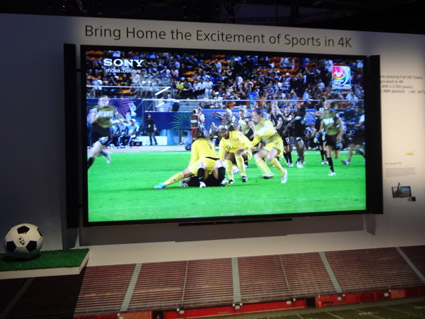UHD television -- we won't get fooled again -- or will we?
PRIME – February 2013
By Gary M. Kaye
Editor, In the Boombox (
www.intheboombox.tv)
The big thing at the Consumer Electronics Show (CES) in Las Vegas was really big – televisions with 84-inch displays, even 110-inch displays.
These weren't just 3D TVs or Smart TVs, or even High Definition (HD) TVs. The consumer electronics industry is betting that this is the next "big thing" – Ultra High Definition TV – which has also been called 4K TV.
These behemoths have about eight million pixels. That's four times (hence the 4K) designation of HDTV. That's just short of the nine million pixels you'll see in a movie theater. The displays are nothing short of spectacular. But so is the pricing. Starting price for these 84-inch UHD TVs can be $25,000. No, I did not mistakenly add an extra zero. Almost every television maker exhibiting on the CES show floor has one of these: Sony, LG, Samsung, Toshiba, Sharp, Westinghouse, Hisense, and at least a dozen other brands.
But pricing isn't the only issue that should be giving consumers pause before buying one of these new TVs. Right now, there is almost nothing to watch on them.
Perhaps the most telling conversation I had all week in Las Vegas was with the vice president of a major television maker, who I will not embarrass by name. When I asked him what content would be available to show on his gorgeous new sets his answer was, "I don't know".
It wasn't helpful, but it was honest.
In order to create content for UHD-TV, the entertainment industry is going to have to spend hundreds of millions, if not billions, to create new cameras, new editing, and new means of recording and transmission. According to another executive, it would take eight of today's Blu-ray disks to play just one UHD movie. There is still no disk recording standard for UHD. That could mean the same kinds of battles we saw going back when it was HD - DVD vs. Blu-ray. In the end, consumers sat on the sidelines refusing to buy either format until the dust settled. And there's no standard for transmitting the bandwidth required by UHD-TV over cable, either.
So, for the near term that means no discs, no UHD cable TV, and no UHD over-the-air. There's not even a standard to push a signal over a High-Definition Multimedia Interface (HDMI) cable from your cable box to these new televisions. The only thing that works so far is a Universal Serial Bus (USB) connection.
For the moment, the manufacturers are trying to tell us that they can do what's known as "upconverting" existing HDTV content to increase the number of pixels. But essentially it's just trying to double the number of pixels while not adding any new content. Even worse, if there are any artifacts – undesired alteration in data – in the original material, upconverting only makes them more obvious.
For the television and movie industries there's a more practical matter. These televisions show so much detail that it's easy to spot flaws from painted scenery to a bad job of makeup. That means that more and more often, scenes will have to be shot in real locales and not on sound stages, and that will drive up production costs.
The only company that's publicly dealing with the lack of content is Sony, which is already producing digital movies in even better than UHD quality. In order to encourage adoption of the new format, Sony has created a video server that will play the higher quality movies. Sony is offering the new server free along with 10 UHD titles to anyone who buys an HDTV set for about $25,000.
That works out to a mere $2,500 per movie, only $2,492 more than a matinee ticket for the same quality movie at my local AMC theater.
What a bargain.
For those of us who cover the consumer electronics industry, this whole UHD thing is d j vu. It's a lot like the 3D hype three years ago when these same companies had us lined up for the coming 3D revolution. They promised us 3D movies. They even promised us a proliferation of 3D cable television channels. But what happened? Almost nothing. Consumers did buy some 3D sets, then bought the active glasses that worked with one maker's sets, but not another's.
Most people who did buy 3D sets admit they seldom use the feature The available 3D movies are mostly animated, with only a handful of live action titles that are worth watching in 3D – "Avatar" and "Life of Pi" come to mind.
If you want to watch either a 3D movie, or a really high quality movie, I harken back to the old adage, "Why buy a cow when the price of milk is so cheap?"
I guess I'd consider a UHD-TV purchase at this point, well, udderly ridiculous.
Gary Kaye is the creator of In The Boombox (
www.intheboombox.tv), the first website to cover technology from the Baby Boomer perspective. Kaye has been covering high tech for more than 30 years with outlets including NBC, ABC, CNN and Fox Business.
He is a regular contributor to AARP and other websites on issues regarding the nexus of technology, seniors and baby boomers.

